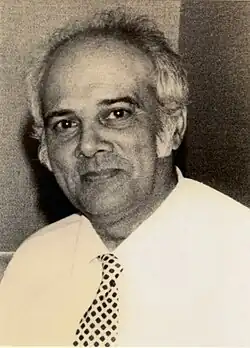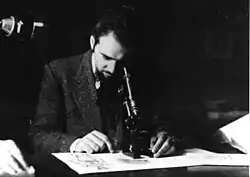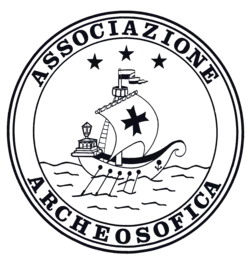Tommaso Palamidessi
Tommaso Palamidessi | |
|---|---|
 | |
| Born | February 16, 1915 Pisa, Italy |
| Died | April 29, 1983 (aged 68) Rome, Italy |
| Philosophical work | |
| Era | 20th-century philosophy |
| Region | Western philosophy |
| School | Christianity |
| Main interests | Esoteric Christianity, yoga, astrology |
| Notable ideas | Archeosophy, archeosophical society |
Tommaso Palamidessi (February 16, 1915 – April 29, 1983) was an Italian philosopher focused on Esotericism. Drawn to astrology, parapsychology, and yoga-tantric doctrines, he was active in the field of the occult and developed archeosophy, which is a form of esoteric Christianity. In 1968, he founded the Archeosophical Society in Rome, which remains active with several thousand members in Europe.[1][2][3][4][5]
Biography
Youth and studies
Palamidessi was born in Pisa on February 16, 1915, to Carlo Palamidessi, an army officer, and Luigia Tagliata, a poet. The Palamidessi family relocated to Sicily in 1920. As a child, Palamidessi studied Astronomy, Astrology, Botany, Medicine and Religion. As an adolescent he travelled to Tripoli and Tunis to further study Islamic Sufism.
In 1933, after moving to Turin Palamidessi began researching astrology, alchemy, Tantric yoga, extrasensory experiences, as well as Egyptology and the study of hieroglyphs. His work on hieroglyphs was carried out in collaboration with Ernesto Scamuzzi, director of the Egyptian Museum of Turin.[6] He also reported experiencing out-of-body experiences, bilocation, and remembrances of past lives.[7]
His publications about Tantric yoga include The Occult Powers of Man and the Indo-Tibetan Tantric Yoga, Sexual Technique of Tantric Yoga; The Erotic Power of Kundalini Yoga; and Yoga not to Die. During these years, he also wrote an extensive unpublished commentary on Egyptian theurgy and the Book of the Dead.[8]
The 1940s and astrological works

Towards the end of the 1940s, Palamidessi began teaching "Astrology and Yoga". According to at least one source, he eventually became one of the primary Italian astrological authors of the 1900s.[9] In the catalogue of the National Library Service, only six astrology treatises written by Italian authors are listed from 1900 to 1939. Most of these treatises are general introductions, often incorporating elements of chiromancy, Physiognomy, and occultism. During this time, Tommaso Palamidessi wrote six astrological treatises: The Course of Stars and Man's Diseases; Medicine and Sidereal Influences; Mundane Astrology (1941); Cosmic Influences and the Precocious Diagnosis of Cancer (1943); Earthquakes, Eruptions and Cosmic influences (1943); and Perpetual Ephemerides (1941)
The first volumes were dedicated to world astrology and medical astrology. At the time, Palamidessi had established connections with exponents of the Hamburg Astrologic School, to whom he dedicated an article in the journal Astral Language. Among his foreign contacts were French authors such as Alexandre Volguine (1903–1976), Henry Joseph Gouchon (1898-1978), and Jacques Reverchon (1909-1985). Reverchon and Gouchon contributed to the journal Cahiers Astrologiques (1938-1983), founded by Volguine. The English writer and Anglican priest Francis Rolt-Wheeler (1876-1960) also collaborated with Palamidessi.
1950s
In 1947, Tommaso Palamidessi married Rosa Francesca Bordino (1916–1999), with whom he had a daughter Silvestra (1948–1996). In 1949, a spiritual crisis drove him to convert to Catholicism and consequently he decided to suspend his yoga publications.
In 1953, he moved to Rome with his family and contributed to various newspapers, including Tribuna Illustrata, an Italian weekly magazine for which he wrote a section about esotericism and astrology until 1969 when the magazine ceased publication. He visited the monasteries of Kalambaka, Thessaly and Mt. Athos in 1957, and Jerusalem during the Easter of 1966, where he claimed to have had special revelations on Mt. Golgotha and Gethsemane.[10]
In Alexandria, Egypt, he visited archaeological sites that he claimed to have seen during his paranormal experiences, through which he had remembered being Origen (185-254), an instructor at the Didaskaleyon founded by Mark the Evangelist in Alexandria. The study of Patristics consolidated his faith in what he regarded as authentic Esoteric Christianity. By this time, his formulation of a new doctrinal synthesis for the spiritual awakening of man and woman took shape in Archeosofica.[11]
Archeosofica

On September 29, 1968, Tommaso Palamidessi founded the Archeosofica, Esoteric School of High Initiation, in Rome. Tommaso Palamidessi described the Archeosofica as
a free school for free scholars, who must not feel like pupils nor apprentices, but brothers who listen to the living voice of other brothers.[...]
It is a call addressed to all, and it does not matter if they belong to the different communities (Theosophists, Anthroposophists, Martinists, Rosicrucians, Catholics, Yoghists, etc.). The Brotherhood is only one, and it can have only one verb: Love one another; only one Master: Jesus the Christ.[12]
In the following years, he journeyed to India, Kashmir, Nepal, China, and South America. From 1968 on, his efforts were focused on the archeosophical doctrine and on the organisation of groups of study and experimentation spread over Italy. In 1973, he founded a cultural association called the Archeosofica intending to develop and diffuse Archeosophy worldwide.
Philosophy
Definition of Archeosophy
Archeosophy is the integral knowledge, it is the archaic wisdom or, in other words, the Science of the Principles. As already said, this word stems from the Greek terms archè (principle) and sophìa (wisdom). Archeosophy facilitates the knowledge of the superior worlds through the development of man of new senses defined as spiritual.[13]
Archeosophy is not only a philosophy that explains the origin and the end of man and of the cosmos of which he is a part, but it is first of all a pure experimental method; it never loses sight of the fact that philosophy has been the surrogate, often unreliable, for the moral and intellectual support of man, who watches impotently at his and others' caducity from birth to death. It holds that philosophy was born when man lost his spiritual contact with the Absolute or Arkè, that is as soon as his dialogue and life of union with God became increasingly obfuscated, fragmentary and doubtful. Philosophy became, in a sense, the instrument for formulating the working hypothesis, the theoretical way to return to the Arkè, full of strident contradictions.
Therefore Archeosophy, before being a philosophy, is continuous experimentation, deep knowledge of ourselves (gnosis), of nature, and of God; it is the reinstatement in the Primordial Tradition, as a true, real, and living contact with the supersensible worlds.
— Tommaso Palamidessi, Archaic Tradition and Foundations of Archeosophical Initiation, 1968
The Archeosophical Ascesis
The archeosophical ascesis aims at solving the religious problem of a correction of human life that does not rely on either one's whim or on chance but on techniques of spiritual awakening and interior transmutation. The programme includes special gymnastics, breathing techniques, and psycho-dynamic actions on hormones and nerve plexus in order to ascend to what corresponds to the body and though not being body makes up the whole of the energetic bodies permeating the organic one with the purpose of finally reaching the causal body where the 'immortal I' resides. Out-of-body experiences (in order to have a direct, personal experience of spiritual worlds), methods of meditation on the spiritual centres directly linked with the three principles of the immortal Ego (such as the meditation on the heart defined by Palamidessi as cardiognosis or "inner knowledge of one's heart') and exercises of remembrance of some past lives are part of the itinerary of self-awareness and of the journey towards God, suggested by Archeosofica.
In his treatise Tecniche di Risveglio Iniziatico (Techniques of Initiatic Awakening) (Ed.Mediterranee 1975) Palamidessi presents a program of integral ascesis where techniques of meditation on the centers of force and on the divine names on the one hand, an intense inner life devoted to transcendence, on the other and finally a cautious use of astral influences in order to determine the most convenient moments for the ascetic practices, converge on the unique purpose of granting a spiritual regeneration in a Christic sense.[14]
Artistic Ascesis
A specific form of ascesis in Archeosophy is expressed through artistic creation. Deeply influenced by the mystical, theological, and artistic traditions of the Eastern Orthodox Church, Tommaso Palamidessi sought to revive traditional techniques for preparing and painting sacred icons. His work on this subject, L'Icona, i colori e l'ascesi artistica (The Icon, Colors, and Artistic Ascesis), published posthumously in 1986, serves as a practical guide for both the creation and contemplation of icons.[15]
According to Palamidessi, by following the principles of chromatic symbolism and the traditional geometry of sacred art, the artist may transform the icon into a "castle of meditation." Through this process, the icon becomes not merely a devotional object but a spiritual tool that allows the artist to transcend the formal aspects of the image and contemplate the divine archetypes it represents.[15] In this context, iconography is seen as both an artistic and mystical discipline with a sanctifying effect on the artist’s consciousness.
Palamidessi also emphasized the role of sacred music in Archeosophical practice. He regarded it as an important medium for spiritual purification and for activating the spiritual centers (chakras) within the individual, contributing to what he described as initiatory and mystical self-realization.[16]
This integration of art and mysticism reflects the broader goals of Archeosophy: to offer a structured path of inner transformation drawing from ancient esoteric, philosophical, and religious traditions.
Works
- Il Corso degli astri e le malattie nell'uomo: trattato teorico-pratico di cosmopatogenesi con 22 figure, Milan: F.lli Bocca, 1940 (2nd ed. Archeosofica 1985).
- La medicina e gli influssi siderali, Milan: F.lli Bocca, 1940.
- Astrologia mondiale: il destino dei popoli rivelato dal corso degli astri, Turin: T. Palamidessi, 1941 (2nd ed. Archeosofica 1985).
- Gli influssi cosmici e la diagnosi precoce del cancro, Turin: T. Palamidessi, 1943.
- Terremoti, eruzioni e influssi cosmici, Turin: T. Palamidessi, 1943.
- I poteri occulti dell'uomo e lo yoga tantrico indo-tibetano, Turin: Spartaco Giovene, 1945 (2nd ed. Archeosofica 1988, 3rd ed. ArkeiosISBN 9788886495233 ).
- La tecnica sessuale dello yoga tantrico indo-tibetano, Turin: Edizioni Grande Opera, 1948 (2nd ed. Archeosofica 1988, 3rd ed. Arkeios ISBN 9788886495226).
- La potenza erotica di kundalini yoga: lo yoga del potere serpentino ed il risveglio dei ventuno chakra, Turin: Grande Opera, 1949.
- Lo yoga per non morire: metodi sperimentali indù per realizzare l'immortalità autocosciente, Turin: Grande Opera, 1949.
- L'alchimia come via allo spirito: l'autorealizzazione magica e la psicologia del profondo, svelate dalla tradizione ermetica, Turin: Grande Opera, 1949 (2nd ed. Arkeios 2001).
- Gli astri nella diagnosi e cura del cancro, Turin: Ed. Grande Opera, 1949.
- Tecniche di risveglio iniziatico: i centri di forza e la metafisica sperimentale, Rome : Edizioni Mediterranee, 1975 (2nd ed. 1983).
- Archeosofia, 5 volumes, Rome: Archeosofica, 1985-1988 (2nd ed. Arkeios 2001, ISBN 9788886495264).
- Il libro cristiano dei morti, Rome: Arkeios, 1985.
- Le basi della teologia sofianica : nuove indagini bibliche, Rome: Arkeios, 1986.
- L'icona, i colori e l'ascesi artistica: dottrina ed esperienze per una Via verso l'autosuperamento ed una coscienza divina nell'arte, Rome: Arkeios, 1986.
- Ricettario Erboristico, Rome: Arkeios, 1987.
See also
References
- ^ Francesco Baroni, Tommaso Palamidessi e l'Archeosofia. Vita ed opere di un esoterista cristiano, Foggia: Bastogi, 2011.
- ^ Massimo Introvigne - Pier Luigi Zoccatelli (editors), Le religioni in Italia, Elledici - Velar, Leumann (Turin) - Gorle (Bergamo), 2006, p. 842-844
- ^ A list of sections of the Archeosophical Society in Italy can be seen on the Associazione Archeosofica Site (retrieved on 14 April 2015) [1]
- ^ Massimo Introvigne, Il Cappello del mago.I nuovi movimenti magici, dallo spiritismo al satanismo, Milan: Sugarco, 1990, p. 330-332 (French translation: La magie: les nouveaux mouvements magiques, Paris : Droguet et Ardant, 1993)
- ^ Günter Bartsch, " Archäosophie – das neue Gralsrittertum ", in Materialdienst der Evangelische Zentralstelle für Weltanschauungsfragen, 1989, 12, p. 369–371.
- ^ Francesco Baroni, Tommaso Palamidessi e l'Archeosofia. Vita ed opere di un esoterista cristiano, Foggia: Bastogi, 2011.
- ^ Massimo Introvigne, Il Cappello del mago.I nuovi movimenti magici, dallo spiritismo al satanismo, Milan: Sugarco, 1990, p. 330-332 (French translation: La magie: les nouveaux mouvements magiques, Paris: Droguet et Ardant, 1993)
- ^ Francesco Baroni, Tommaso Palamidessi e l'Archeosofia. Vita ed opere di un esoterista cristiano, Foggia: Bastogi, 2011.
- ^ Francesco Baroni, " Tommaso Palamidessi et l'Archéosophie ", in La Tentation du secret, Groupes et sociétés initiatiques entre ésotérisme et politique du XVIIIème au XXème siècle, Politica Hermetica n° 21 (2007), p. 120-135.
- ^ Massimo Introvigne, Il Cappello del Mago. I nuovi movimenti magici, dallo spiritismo al satanismo, Milan: Sugarco, 1990, p. 330-332 (French translation: La magie: les nouveaux mouvements magiques, Paris: Droguet et Ardant, 1993)
- ^ Francesco Baroni, Tommaso Palamidessi e l'Archeosofia. Vita ed opere di un esoterista cristiano, Foggia: Bastogi, 2011.
- ^ Tommaso Palamidessi Archeosofia, en 5 volumes, Rome: Archeosofica, 1985-1988
- ^ Tommaso Palamidessi, Tecniche di risveglio iniziatico: i centri di forza e la metafisica sperimentale, Rome : Edizioni Mediterranee, 1975
- ^ Tommaso Palamidessi, Tecniche di risveglio iniziatico: i centri di forza e la metafisica sperimentale, Rome : Edizioni Mediterranee, 1975 (2nd ed. 1983).
- ^ a b Palamidessi, Tommaso (1975). L'icona, i colori e l'ascesi artistica: dottrina ed esperienze per una Via verso l'autosuperamento ed una coscienza divina nell'arte (in Italian) (2nd ed.). Rome: Edizioni Mediterranee.
- ^ Palamidessi, Tommaso (1977). Archeosofia (in Italian). Rome: Edizioni Archeosofica.
In English:
- Article " Archeosophy " by P.L. Zoccatelli in Peter B. Clarke (ed.), Encyclopedia of New Religious Movements, London - New York: Routledge, 2006, p. 38-39.
In Italian, German and French:
- Günter Bartsch, " Archäosophie – das neue Gralsrittertum ", in Materialdienst der Evangelischen Zentralstelle für Weltanschauungsfragen, 1989, 12, p. 369–371.
- Massimo Introvigne, Il Cappello del mago.I nuovi movimenti magici, dallo spiritismo al satanismo, Milan: Sugarco, 1990, p. 330-332 (French translation: La magie: les nouveaux mouvements magiques, Paris : Droguet et Ardant, 1993).
- Cecilia Gatto Trocchi, Magia ed esoterismo in Italia, Milano:Mondadori, 1990, p. 142-145.
- Antoine Faivre, L'ésotérisme, Paris : PUF, 1992, p. 102.
- Massimo Introvigne - Pier Luigi Zoccatelli (editors), Le religioni in Italia, Elledici - Velar, Leumann (Turin) - Gorle (Bergamo), 2006, p. 842-844.
- Francesco Baroni, " Tommaso Palamidessi et l'Archéosophie ", in La Tentation du secret, Groupes et sociétés initiatiques entre ésotérisme et politique du XVIIIème au XXème siècle, Politica Hermetica n° 21 (2007), p. 120-135.
- Francesco Baroni, "Julius Evola e Tommaso Palamidessi. Con una lettera inedita di Julius Evola", 2009 (http://www.fondazionejuliusevola.it/Documenti/Evola_Palamidessi.pdf).
Books:
- Francesco Baroni, Tommaso Palamidessi e l'Archeosofia. Vita ed opere di un esoterista cristiano, Foggia: Bastogi, 2011.